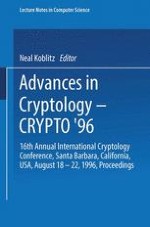Crypto '96, the Sixteenth Annual Crypto Conference, is sponsored by the International Association for Cryptologic Research (IACR), in cooperation with the IEEE Computer Society Technical Committee on Security and P- vacy and the Computer Science Department of the University of California at Santa Barbara (UCSB). It takes place at UCSB from August 18 to 22, 1996. The General Chair, Richard Graveman, is responsible for local organization and registration. The scientific program was organized by the 16-member Program C- mittee. We considered 115 papers. (An additional 15 submissions had to be summarily rejected because of lateness or major noncompliance with the c- ditions in the Call for Papers.) Of these, 30 were accepted for presentation. In addition, there will be five invited talks by Ernest Brickell. Andrew Clark, Whitfield Diffie, Ronald Rivest, and Cliff Stoll. A Rump Session will be chaired by Stuart Haber. These proceedings contain the revised versions of the 30 contributed talks. least three com- The submitted version of each paper was examined by at mittee members and/or outside experts, and their comments were taken into account in the revisions. However, the authors (and not the committee) bear full responsibility for the content of their papers.
